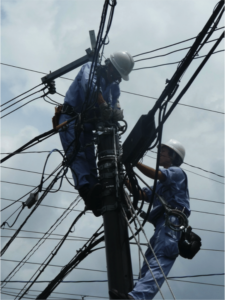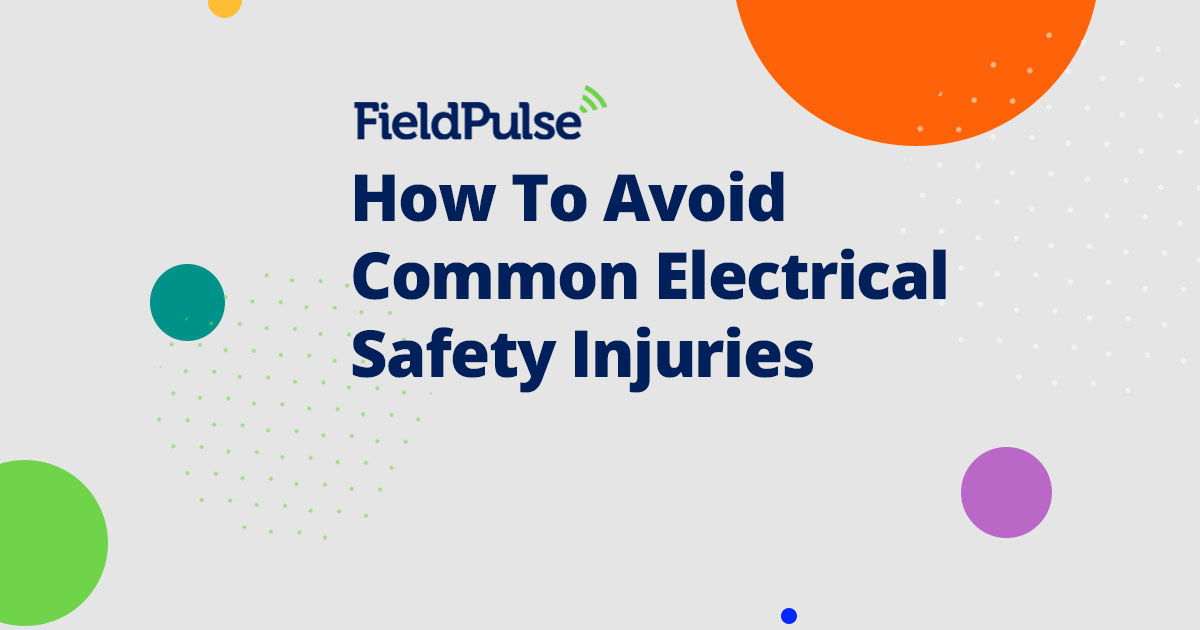*Note: this is a guest post from My Bootprint – a website that helps workers pick the best boots for their job

An average of 300 electrocutions and about 4,000 electrical related injuries on the workplace happen each year in the US. This leads to fatalities and serious injuries which affect the performance and productivity of the companies and serious disruptions to the employees and their families.
Electrical hazards exist on various worksites, so being aware of the types of possible electrical hazards at ones job is crucial for preventing injuries and electrocutions not only for professional electricians but for other workers as well.
Here are the best ways to avoid common electrical safety injuries at work:
1. Know the most common electrical hazard risks
Nearly 40% of the fatalities due to electrocution at work are as a result of getting into contact with overhead powerlines. Other risks include: running into live electrical currents in the wiring or the machines and transformers on the job.
Very often the injuries and fatalities occur due to improper use of the equipment and lack of adequate training and regular assessments for safe work.
2. Avoid taking shortcuts when doing your job
Take all the necessary steps when performing a task. Don’t skip checking the electrical sources before contacting them. Do not be tempted to skip a safety precaution or an important step in your work in order to save time.
According to the Occupational Safety and Health Administration (OHSA), many of the injuries and electrocutions of workers were due to the fact that they were unaware of the live electrical sources they came into contact with. Also, never ask an unqualified person to do a job where electrical hazards exist.
3. Know how to avoid electrical related injuries
Initial and continuous training as well as practice is needed in order to prevent electrical hazard injuries and fatalities. Rushing through the job or doing something you are not completely sure of is something which can cause serious injuries and even lead to death.
People who work with electricity and electrical systems must be able to identify the possible electrical hazards, including:
– Electrical shocks, blasts or burns
– Fault current
– Specific electrical safety in the industry
– The characteristics of blast dangers and an arc flash hazard
– The exposure to current which can cause third degree burns in just 1/10th of a second
4. You don’t need to be a professional electrician to be exposed to electrical hazards
When working with your electrical system at home, you should be aware of all the potential electrical hazard risks.
– Do not begin work before performing a proper inspection to identify potential dangers
– Always check whether your power receptacles have a ground-fault circuit interrupter
– Also, make sure that all receptacle, the installation and the outlet box have covers, and if the covers are from metal that they are properly grounded
– Use appropriate wiring and other substitutions when working on the electrical system, and do not assume that electric tape is an acceptable solution to hide exposed live wires
– Have a plan of where the wiring of your electrical system is placed through the walls, floors, ceilings, windows and doors
– Be aware of power cords which somebody can trip on and break, or power cords which can be damaged due to opening and closing of windows and doors
– Inspect your extension cord for possible damage, tears, pinches or missing grounding pins. If there is such damage replace it with a new one
– Test all ground conductors in your home at least once in every three months
– Have a plan of where the wiring of your electrical system is placed through the walls, floors, ceilings, windows and doors
– Be aware of power cords which somebody can trip on and break, or power cords which can be damaged due to opening and closing of windows and doors
– Inspect your extension cord for possible damage, tears, pinches or missing grounding pins. If there is such damage replace it with a new one- Test all ground conductors in your home at least once in every three months
– Inspect your extension cord for possible damage, tears, pinches or missing grounding pins. If there is such damage replace it with a new one- Test all ground conductors in your home at least once in every three months
– Test all ground conductors in your home at least once in every three months
5. Awareness of the tools you are using
Apart from being aware of the electrical hazards at your workplace, you also must know how to safely work with the tools you are using for the job. Improper use of a tool can be dangerous.
Also, make sure that all the circuit breakers are clearly identified. If there are breakers which you cannot identify – make sure you check it and understand its relevance.
6. Staying safe from arc flashes
Arc flashes are a common electrical hazard. They happen due to a short circuit or other electrical fault, and can vary in size, due to factors such as: the voltage, amperage, the closure time and the size of the gap.
Arc flashes can be very dangerous due to their:
– Thermal energy can reach 35,000 degrees Fahrenheit which is more than the heat on the surface of the sun and can injure or kill not only the worker but those standing in more than 10 feet from it
– The pressure applied to the human body can cause injuries, rupture eardrums and others
– Acoustic energy – the sound can reach dangerous levels of about 160 decibels
– The debris can be blown and can injure somebody
To prevent this, always lock out the circuit after you de-energize it when working on the electrical system.
Also, limit the approach to the potentially risky area to boundaries which can be calculated by the IEEE standard 1584.
7. Continuous safety training and assessment
Only professional electricians should work on electrical systems and machinery. The electrician should be properly trained to use all the tools necessary and to take all safety precautions before, during and after completing a task. Implementing safety procedures, safety monitoring and wearing the appropriate safety and protective personal equipment gear and footwear is also a must. Take into consideration the specific risks at your workplace when choosing the right work boots for electricians.
If necessary, daily or weekly safety training and instructions should be performed. Constant monitoring of the compliance with the safety procedures by the safety directors or other employees is crucial too.Author bio: Michael Pierce is an outdoor enthusiast and footwear fanatic.
When he is not working or writing about work footwear, you can find him spending time with his family. He runs two websites dedicated to quality footwear – MyBootprint with special focus on work boots, and ShoeMatters – a site focused on comfortable footwear for different activities.


